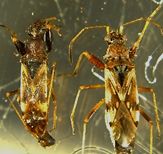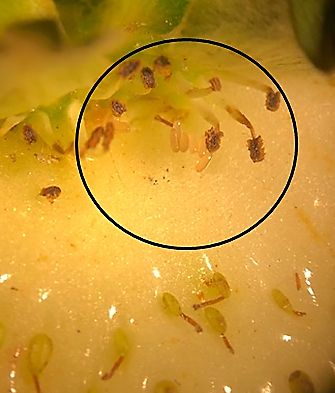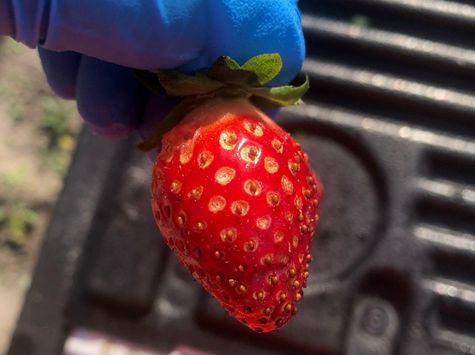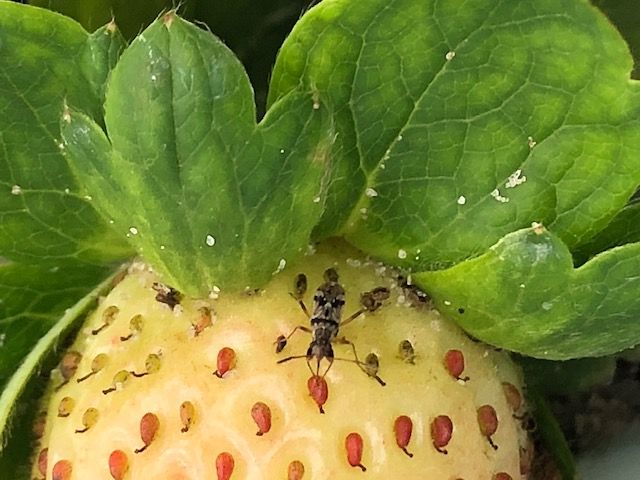This document is intended for the general public, UF/IFAS Extension agents, and organic strawberry growers to provide an overview of seed bugs in organic strawberry systems in Florida. This information includes monitoring and management options for strawberry seed bugs (Neopamera bilobata) in organic strawberry production.
Introduction
The strawberry seed bug (Neopamera bilobata (Say) (Hemiptera: Rhyparochromidae) has become a significant pest for organic and conventional strawberry producers. Populations of strawberry seed bugs have traditionally been managed in conventional strawberry systems with insecticides that target other pests, including chilli thrips and armyworms. Still, the lack of insecticidal tools in organic production has resulted in substantial population outbreaks. The strawberry seed bug is native to North America with reports in South and Central America.
Description and Life Cycle
The strawberry seed bug is about 5–6 mm (0.22 inches) long with vertical spines on the fore femur (Dellape 2005). This true bug can be identified by its fourth antennal segment, which is entirely brown (Dellape 2005). Males generally have larger spines on the fore femur and are smaller in size than females (Figure 1). Adult seed bugs can live for approximately a month and become active when the temperature exceeds 23.8°C (75°F) with relative humidity above 65% (Kuhn et al. 2014). However, it appears that warm winters promote high seed bug activity. In central Florida, adult seed bugs become active in the field during late fall (November to December), and peak nymphal activity appears to be in January and February. Adult seed bugs fly and mate on strawberry fruit. One mated female can lay approximately 100–300 viable eggs in her lifetime (~8 a day) when conditions are favorable (Kuhn et al. 2014). Newly laid eggs are tan and can be found under the calyx of the strawberry (Figure 2). Once eggs are fully mature, they turn red. At optimum temperatures (24oC ± 1oC), seed bug eggs take approximately 10 to 11 days to hatch into unsclerotized first-instar reddish nymphs that are 1 mm (0.04 inch) long (Kuhn et al. 2014). Sclerotized first-instar nymphs can be mistaken for small black ants (Schuh and Slater 1995). Strawberry seed bugs go through five nymphal stages before reaching adulthood, which takes an average of 35 days on a strawberry host.

Credit: Hannah Talton, UF/IFAS

Credit: Hannah Talton, UF/IFAS
Once established, seed bug populations find refuge under plastic mulch, weeds (Cuda et al. 2007; Wheeler et al. 2010; Wheeler 2016), and strawberry plants. Due to the long strawberry season in central Florida (October to March), seed bugs have an abundant food source (Bielinski 2009). At the end of the season, seed bugs feed on alternative hosts such as pinecones, torpedo grass, and figs, but return to strawberry fields (the preferred host) the following season. Cold winters and frost in the spring can cause the seed bug population to decline and go into a quiescent state (meaning that they pause growth and reproduction until ideal conditions return). In one strawberry season there can be approximately two to four generations of seed bugs in north-central Florida (Kuhn et al. 2014).
Injury
Seed bug nymphs and adults cause injury to ripe strawberry fruit by feeding on the achenes. The hemipteran insects can inject enzymes to penetrate the achenes and obtain nutrients (Brambila et al. 2008). Once fed on, the achenes dry up and fall off, leaving behind tan spots visible on the receptacle (Figure 3). Nymphs may also feed on immature fruit, but more research needs to be done to substantiate this hypothesis (Kuhn 2014). Feeding on the seeds can affect fruit development and severely impact yields (Brooks et al. 1929). Seed bugs feeding on the seeds can reduce the aesthetic value of marketable fruit and berry size. It should be noted that malformation of fruit could also be caused by environmental factors such as frost damage or poor pollination (Ernest and Johnson 2020). The strawberry seed bug uses its sensory organs to probe strawberry seeds. It can be attracted to different strawberry cultivars depending on the seeds' position (sunken or on the surface) (Talton et al. 2020). Cultivars with sunken seeds appear to suffer less injury. Strawberry seed bugs can feed on attached (Figure 4) and detached strawberry seeds. Currently, there is no economic threshold (ET) or economic injury level (EIL) for seed feeding N. bilobata.

Credit: Hannah Talton, UF/IFAS

Credit: Hannah Talton, UF/IFAS
Monitoring and Management
Populations of strawberry seed bugs can be monitored with the use of different techniques. Yellow sticky cards can be used to monitor adult strawberry seed bug populations. Yellow sticky cards on 12-inch-long stakes can be placed inside strawberry holes and positioned just above the crop canopy to catch adults when they take flight (Botton et al. 2017). Alternatively, a white beat sheet can be used to monitor strawberry seed bug nymphal instar populations (Botton et al. 2017). The white beat sheet should be placed under strawberry plants to capture instars that hide under leaves and fruit. Slight agitation of the plant should be enough to detach the nymphs from the vegetation onto the beat sheet for population counts.
Research into effective management tools for this seed bug pest is still ongoing. Techniques that have been researched include the intercropping (crops planted between rows of commodity crops) of garlic between strawberries, which has proven to be a positive cultural control method to reduce seed bug populations in greenhouse production (Hata et al. 2018). Removing runners and proper weed management may reduce seed bug injury to strawberry fruit by eliminating potential refuge areas (Talton et al. 2020, et al. 2008, Hughes et al. 2017). Strawberry seed bug populations can also be managed in greenhouses, high tunnels, and open fields by using conventional handheld vacuums (Talton et al. 2020). There are no commercial insecticides explicitly labeled for this particular seed bug pest.
Organic insecticides such as Azera® (pyrethrins + azadirachtin), Azamax® (azadirachtin), Entrust® SC Naturalyte (spinosad), and PyGanic® (pyrethrins) have been tested and have shown promising results for reducing populations of strawberry seed bugs (Talton et al. 2020). Insecticide applications should be applied when adults first enter the production field, which can be as early as September or as late as November in north central Florida. Spraying adults can decrease the chances of oviposition (egg laying). It should be noted that contact insecticide usage on adult and nymphal seed bugs can be challenging due to their ability to hide under vegetation and black plastic mulch. Please read the label and follow all directions for rates, frequency of application, and restrictions.
Selected References
Bielinski M. S., K. C. Craig, R. S. Maricruz, and P. S. Teresa. 2009. “Evaluation of Strawberry Cultivars in Florida” International Journal of Fruit Science 9: 419–424. https://doi.org/10.1080/15538360903378765
Botton, M., T. M. Kuhn, M. A. C. Zawadneak, and A. E Loeck. 2016. “Bioecology and Characterization of Neopamera bilobata (Say, 1832) (Hemiptera: Rhyparochromidae) Damage in Strawberry.” Brazilian Agricultural Research Corporation Embrapa Clima Temperado, Brasilia, Brazil. 194:10.
Brambila, J., and G. S. Hodges. 2008. “Bugs (Hemiptera).” In Encyclopedia of Entomology edited by J. L. Capinera. Springer: Dordrecht, The Netherlands; Volume 2, pp. 591–611.
Cuda, J. P., J. C. Dunford, and J. M. Leavengood Jr. 2007. “Invertebrate Fauna Associated with Torpedograss, Panicum repens (Cyperales: Poaceae), in Lake Okeechobee, Florida, and Prospects for Biological Control.” Florida Entomologist 90:238–248. https://doi.org/10.1653/0015-4040(2007)90[238:IFAWTP]2.0.CO;2
Dellape, P. M. 2005. “Biodiversity, Phylogenetic Relationships and Biogeographic Aspects of Rhyparochromidae (Lygaeoidea: Heteroptera) COM Special Reference to Genus Neopamera Harrington 1980.” – Faculty of Natural Sciences and Museum, National University of La Prata, La Plata, Argentina. 249pp.
Domoto, P. A., M. Gleason, and D. Lewis. 2008. “Production Guide for Commercial Strawberries.” Iowa State University Extension and Outreach. PM 672D.
Ernest, E. G., and G. Johnson. 2020. “Misshapen Strawberry Fruits, Cold Damage and Frost Injury.” Weekly Crop Update. UD Cooperative Extension, Newark, Delaware. https://sites.udel.edu/weeklycropupdate/?p=14676
Hata, F. T., M. U. Ventura, V. L. Béga, I. M. Camacho, and M. De Paula. 2018. “Chinese Chives and Garlic in Intercropping in Strawberry High Tunnels for Neopamera bilobata Say (Hemiptera: Rhyparochromidae) Control.” Bulletin of Entomological Research 1–7. https://doi.org/10.1017/S0007485318000299
Hughes, B. R., J. Zandstra, T. Taghavi. and A. Dale. 2017. “Effects of Runner Removal on Productivity and Plant Growth of Two Day-Neutral Strawberry Cultivars in Ontario, Canada.” Acta Horticulturae 1156:327–332. https://doi.org/10.17660/ActaHortic.2017.1156.50
Kuhn, T. M. 2014. “Bioecology, Characterization of Injuries and Effect of Insecticides on Neopamera sp. aff. Bilobata (Say, 1832) (Hemiptera: Rhyparochromidae) in Strawberry.” Dissertation (Master's degree in science) – Faculty of Agronomy, Elisha Maciel, Federal University of Pelotas, Pelotas, Brazil. 66pp. https://doi.org/10.1590/S0100-204X2014000600003
Kuhn, T. M. A., A. E. Loeck, M. A. C. Zawadneak, M. S. Garcia, and M. Botton. 2014. “Parâmetros biológicos e tabela de vida de fertilidade de Neopamera bilobata (Hemiptera:Rhyparochromidae) em morangueiro.” Pesquisa Agropecuária Brasileira 49:422–427.
Schuh, R. T and J. A. Slater. 1995. The True Bugs of the World (Hemiptera: Heteroptera). Classification and Natural History. Cornell University Press, Ithaca, New York. 336 pp.
Talton, H. R., E. M. Rhodes, C. A. Chase, M. E. Swisher, J. M. Renkema, and O. E. Liburd. 2020. “Effect of Cultural Practices on Neopamera bilobata in Relation to Fruit Injury and Marketable Yields in Organic Strawberries.” Insects 11:843. https://doi.org/10.3390/insects11120843
Wheeler Jr, A. G., and C.A. Stoops. 2010. “Cnemodus hirtipes Blatchley and C. mavortius (Say) (Hemiptera: Lygaeoidea: Rhyparochromidae) in Fallen Pinecones, with Consideration of the Biological Significance of Cone Occupancy.” Proceedings of the Entomological Society of Washington 112:155–168. https://doi.org/10.4289/0013-8797-112.1.155
Wheeler, A. G. 2016. “Neopamera bilobata (Say) and Ozophora trinotata Barber (Hemiptera: Lygaeoidea: Rhyparochromidae) as Frugivores on Florida Rosemary (Ceratiola ericoides; Ericaceae).” Proceedings of the Entomological Society of Washington 118:424–435. https://doi.org/10.4289/0013-8797.118.3.424
Zalom, F. G., M. P. Bolda, S. K. Dara, and S. Joseph. 2015. “UC IPM Pest Management Guidelines: Strawberry.” UC ANR Publication 3468.